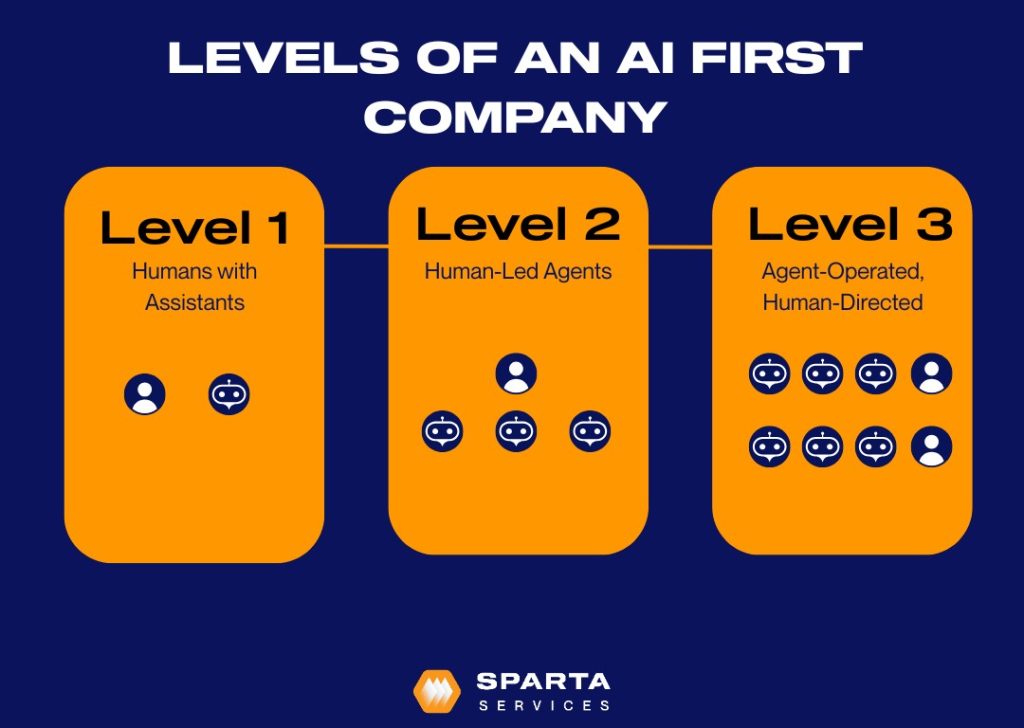The AI Hype Problem
Plenty of organizations have experimented with AI, but not many have seen it stick. Maybe a department launched a promising pilot. Maybe a vendor demo looked impressive. But somewhere between proof of concept and production, the momentum fades.
That’s usually because the work starts in isolation, without a plan, without the right team, and without a clear business problem to solve. Pilots get stuck. Teams aren’t sure how to measure progress. And concerns around data, privacy, and security bring everything to a halt.
We’re also seeing more teams jump into building AI agents – automated tools that can act, respond, and even make decisions. It’s a powerful direction, and we’ll be diving deeper into it in an upcoming post. But like any AI application, agents need structure and accountability to deliver real value.
What works? A focused, organization-wide strategy. One that aligns to business goals, builds buy-in across teams, and doesn’t treat AI as a side project.
Why Do Random AI Pilots Fail?
AI is not plug-and-play. It requires context, direction, and patience.
Too often, companies start with a promising use case but don’t have the structure to support it. A department may try automating a process or generating reports with a new AI tool, but if leadership isn’t aligned or there’s no system for tracking success, the pilot drifts off course.
Here are the most common failure points we see:
- No defined vision or business problem. If AI isn’t solving something specific, it’s solving nothing.
- Tech-driven instead of outcome-driven. When the AI tool leads the process instead of the business need, impact is hard to prove.
- Siloed execution. AI pilots run in isolation without support from IT, compliance, or operations, limiting scalability.
- No metrics, no momentum. Without KPIs, it’s impossible to prove value or decide what to refine, stop, or scale.
And the data supports what we’re seeing in the field.
According to S&P Global Market Intelligence, in 2025, 42% of organizations have scrapped most of their AI initiatives, up from 17% in 2024. Up to 80% of AI proof-of-concepts never make it to production. Top reasons for this include rising costs, complexity, data access issues, and security concerns.
In short, AI doesn’t fail because it lacks potential. It fails because it lacks planning.
What Is an AI Transformation Strategy?
Organizations that succeed with AI don’t start with tools. They start with strategy.
Microsoft recently used a three-tier system to describe a company’s level of AI transformation:

Level 1: Humans with Assistants. Companies are starting to use AI assistants, but humans are doing the majority of the work. AI assistants can be used to polish writing, help draft emails, fill in CR notes, etc.
Level 2: Human-led Agents. Humans steer; agents execute. This means multi-step flows, prospect cadences, automatically-built reports. Agents trigger each other while humans watch the dashboard.
Level 3: Agent-Operated, Human-Directed. Now whole workflows run themselves across the company – sales, finance, support. Humans set targets and agents negotiate the route.
Most companies land somewhere between level 1 and 2, never reaping the productivity boost that comes with achieving level 3. An AI transformation plan brings focus, structure, and accountability. It aligns business and technical teams around shared goals and ensures AI projects don’t operate in silos, enabling company-wide embrace of the technology.
What Should Be Included in an AI Transformation Plan?
- Executive alignment and vision. Leaders must be aligned on the “why” of AI – what problems are being solved and why now.
- Use case prioritization. Not all AI projects deliver equal value. Focus on use cases with clear impact and available data.
- Change management. AI changes how people work. Adoption depends on how well teams are prepared, trained, and supported.
- Ongoing measurement and iteration. AI isn’t set-it-and-forget-it. You need feedback loops to adjust models and improve outcomes.
- Planning for scale, especially with agents. As task-specific agents become more common, planning for oversight, role boundaries, and system integration is essential.
Microsoft’s Four Pillars of AI Transformation provide a helpful framework to map initiatives:
- Empower Employees: Make teams more effective with tools that support focus, decision-making, and creativity.
- Engage Customers: Use AI to deliver personalized, consistent interactions at scale.
- Optimize Operations: Automate repetitive workflows and surface hidden insights to improve efficiency.
- Transform Products: Add intelligence to your offerings, whether through embedded AI features or smarter service delivery.
These pillars ensure AI doesn’t just improve processes, it reshapes how business gets done.
Leveraging Microsoft Copilot in AI Transformation
Microsoft Copilot is way more than a simple AI assistant, it’s a foundational component of enterprise AI transformation. It brings AI into the tools employees already use: Outlook, Excel, Teams, Word, Power BI, and more.
With Copilot, organizations can:
- Automate repetitive tasks like summarizing threads, drafting responses, or generating reports
- Provide AI-powered suggestions based on company knowledge and context
- Extract insights from documents, emails, meetings, and databases, both structured and unstructured
- Support real-time decision-making across departments, from finance to HR to customer service
Perhaps most importantly, Copilot sets the stage for broader use of agents. It introduces the concept of AI acting on your behalf in a secure, governed way. As organizations grow more comfortable with Copilot, they’re better prepared to develop custom agents that handle more complex, high-value tasks.
Benefits of a Microsoft-Aligned AI Strategy
Done right, an AI transformation driven by tools like Microsoft Copilot brings measurable benefits:
- Increased productivity. Reduce time spent on repetitive tasks and free employees to focus on strategic work.
- Faster time-to-value. Launch AI use cases that deliver impact within weeks, not months.
- Better customer experiences. Use data-driven insights to respond faster and with more precision.
- Operational efficiency. Automate bottlenecks and streamline decision-making across departments.
- Stronger enterprise security. Use built-in access controls, compliance tooling, and Microsoft’s security infrastructure to protect data and reduce risk from shadow AI deployments.
This last point is critical: as organizations adopt more AI, enterprise security must scale with it. Microsoft’s tools are built with this in mind, offering transparency, audit trails, and data residency controls, features many standalone AI tools don’t offer.

Measurement is Non-Negotiable
The difference between a pilot and a program is measurement.
Without clear KPIs, AI work becomes anecdotal. People may feel it’s working – or not – but no one can point to results. This makes it difficult to secure future investment or course-correct when something’s off.
What should you measure?
- Business impact: Revenue gains, cost savings, efficiency improvements
- Adoption rates: Are people actually using the tools, and how often?
- Time to value: How quickly do use cases start producing results?
- AI accuracy and reliability: Are the outputs consistent and useful?
- Employee and customer satisfaction: Are outcomes improving experience?
Measuring impact gives you the insight to scale with confidence – or pull back when something isn’t working. Either way, it turns AI into a business tool, not just a tech experiment.
What Are AI Agents and Why Should You Plan for Them?
What is an AI agent?
AI agents are task-specific tools that act on behalf of users. They can make decisions, complete workflows, and operate across enterprise systems.
Why are AI agents important?
Agents represent the next step in AI maturity. They work alongside Copilot tools to automate more complex, multi-step tasks – but only when deployed with the right structure and safeguards.
Planning for agents early helps organizations:
- Set clear boundaries for agent actions
- Ensure role-based access and compliance
- Build trust across teams for automation at scale
Agents are much bigger topic, and we’ll dive deeper into it in a future blog post.
How Do You Build an AI Transformation Strategy?
The pressure to implement AI is real. But moving too fast – or without a plan – leads to wasted effort and missed opportunities.
Before launching another pilot or building a bot, step back. Align on goals. Identify your best opportunities. Build a plan you can measure, adapt, and scale.
Here’s how to move forward:
- Explore Microsoft Copilot. Get the most out of the tools your team already uses, with governance and security baked in.
- Partner with Sparta Services. Our AI transformation framework helps organizations define priorities, align teams, and deliver real outcomes. Get in touch today to find out how we can help your organization.

Dave Galy
Dave Galy is the founder and CEO of Sparta Services


